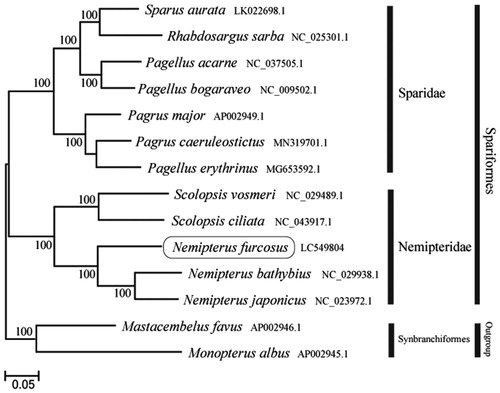Abstract
The complete mitochondrial genome of the fork-tailed threadfin bream, Nemipterus furcosus, which belongs to the family Nemipteridae was first determined. The complete mitochondrial genome was 16,882 bp in size and encoded of 13 protein-coding genes, 22 tRNA genes, 2 rRNA genes, and a control region. Nemipterus furcosus has a mitochondrial gene arrangement that is typical of vertebrates. Phylogenetic analysis using mitochondrial genomes of 11 related species revealed that N. furcosus formed a well-supported monophyletic group with the other Nemipteridae species. This mitochondrial genome provides a useful information for addressing taxonomic issues.
The fork-tailed threadfin bream, Nemipterus furcosus (Spariformes, Nemipteridae), is a tropical reef-associated marine fish widely distributed in the West Pacific from southern Japan to northeastern Australia, and Indian Ocean including the Gulf of Mannar, Sri Lanka, Andaman Sea, Strait of Malacca and northwestern Australia (Russell Citation1990). The placement of the Nemipteridae and associated families (Sparidae and Lethrinidae) has been controversial in the order Spariformes. Although molecular and morphological studies reported the Nemipteridae belong to the order Spariformes (Johnson Citation1981; Carpenter and Johnson Citation2002; Sanciangco et al. Citation2016), the position of this family is unclear. Here, we first determined the complete mitochondrial genome sequence of N. furcosus and analyzed the phylogenetic relationship of this species with members of Nemipteridae and Sparidae.
The N. furcosus specimen was collected from Ho Chi Minh City, Vietnam (10.53 N, 106.45 W). Total genomic DNA was extracted from the specimen tissue, which has been deposited at the National Marine Biodiversity Institute of Korea (Voucher No. MABIK0002423). The mitogenome was sequenced using Illumina Hiseq 4000 sequencing platform (Illumina, San Diego, CA) and assembled with SOAPdenovo at Macrogen Inc. (Seoul, Korea). The complete mitochondrial genome was annotated using MacClade ver. 4.08 (http://macclade.org/macclade) (Maddison and Maddison Citation2005) and tRNAscan-SE ver. 2.0 (http://lowelab.ucsc.edu/tRNAscan-SE) (Lowe and Chan Citation2016).
The complete mitochondrial genome of N. furcosus (GenBank accession no. LC549804) is 16,882 bp in length and includes 13 protein-coding genes, 22 tRNA genes, 2 rRNA genes, and a control region. The overall base composition is 28.14% A, 28.46% C, 16.79% G, and 26.61% T. Similar to the mitogenomes of other vertebrates, the AT content is higher than the GC content (Saccone et al. Citation1999). All tRNA genes can fold into a typical cloverleaf structure, with lengths ranging from 66 to 74 bp. The 12S rRNA (1000 bp) and 16S rRNA genes (1758 bp) are located between tRNAPhe and tRNAVal and between tRNAVal and tRNALeu(UUR), respectively. Of the 13 protein-coding genes, 12 start with ATG; the exception being COI, which starts with GTG. The stop codon of the protein-coding genes is TAA (ND1, COI, ATP8 and ND6), T (COII, ND3, ND4 and Cytb), TA (ND2, ATP6 and COIII), TAG (ND4L) and AGA (ND5). A control region (1096 bp) is located between tRNAPro and tRNAPhe.
The phylogenetic trees were constructed by the maximum-likelihood method using MEGA 7.0 software (MEGA, Philadelphia, PA) (Kumar et al. Citation2016). We analyzed the phylogenetic trees of the newly sequenced genome and 11 other complete Nemipteridae and Sparidae species mitochondrial genome sequences acquired from the National Center for Biotechnology Information. We confirmed that N. furcosus formed a monophyletic group with the other Nemipteridae species (). This mitochondrial genome provides an important resource for addressing taxonomic issues.
Disclosure statement
No potential conflict of interest was reported by the author(s).
Data availability statement
The data that support the findings of this study are openly available in the DNA Data Bank of Japan (accession no. LC549804) at https://www.ddbj.nig.ac.jp.
Additional information
Funding
References
- Carpenter KE, Johnson GD. 2002. A phylogeny of sparoid fishes (Perciformes, Percoidei) based on morphology. Ichthyol Res. 49(2):114–127.
- Johnson GD. 1981. The limits and relationships of the Lutjanidae and associated families. Bull Scripps Inst Oceanogr. 24:1–114.
- Kumar S, Stecher G, Tamura K. 2016. MEGA7: molecular evolutionary genetics analysis version 7.0 for bigger datasets. Mol Biol Evol. 33(7):1870–1874.
- Lowe TM, Chan PP. 2016. tRNAscan-SE On-line: integrating search and context for analysis of transfer RNA genes. Nucleic Acids Res. 44(W1):W54–W57.
- Maddison DR, Maddison WP. 2005. MacClade 4 ver. 4.08: analysis of phylogeny and character evolution. Sunderland (MA): Sinauer Associates.
- Russell BC. 1990. Nemipterid fishes of the world. (threadfin breams, whiptail breams, monocle breams, dwarf monocle breams, and coral breams). Family Nemipteridae. An annotated and illustrated catalogue of Nemipterid species known to date. FAO Fisheries Synopsis. 12(125):34–35.
- Saccone C, De Giorgi C, Gissi C, Pesole G, Reyes A. 1999. Evolutionary genomics in Metazoa: the mitochondrial DNA as a model system. Gene. 238(1):195–209.
- Sanciangco MD, Carpenter KE, Betancur-RR. 2016. Phylogenetic placement of enigmatic percomorph families (Teleostei: Percomorphaceae). Mol Phylogenet Evol. 94(Pt B):565–576.

